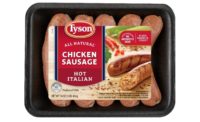"Producer profitability will determine the amount of protein available to be consumed in the future," he said. "That concept hasn't changed; however, the drivers of profitability and production have changed.
"The old paradigm was that profitability and production are driven by domestic demand. The new paradigm is that they're largely driven by grain costs and exports," Lochner said at the J.P.Morgan Global Protein Conference. Dennis Leatherby, Tyson's executive vice president and chief financial officer, also represented the company at the conference.
This shift in input costs began in the mid 2000s, which coincides with the U.S. government's mandate that a portion of the nation's gasoline be mixed with ethanol at a level of 10%. Ethanol in the United Sates is made primarily from corn, which is also a primary ingredient in livestock feed.
Today, about 40% of the U.S. corn crop is used in ethanol production. This new demand has contributed to historically high corn prices. High input costs, along with increasing global demand for protein, have reduced the amount of meat and poultry available, resulting in higher protein prices for consumers, he added.
"Total production of major proteins appears to be about flat versus last year, but with extremely strong exports, it's likely there will be even less meat and poultry per capita," Lochner said while showing a chart illustrating four years in row of declining domestic protein availability.
Lochner added that Tyson Foods is well positioned with its focus on four primary objectives:
- Being the customers' "go-to supplier" by helping them succeed through service, innovation and insight driven food solutions
- Being the "best in class" protein producer by optimizing commodity businesses and driving out inefficiencies
- Building a multinational enterprise with operations in Mexico, China, Brazil and India
- Upgrading raw material through initiatives such as renewable energy from animal fat and other technologically advanced platforms.
Source: Tyson Foods Inc.








